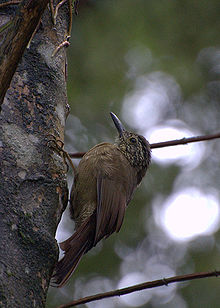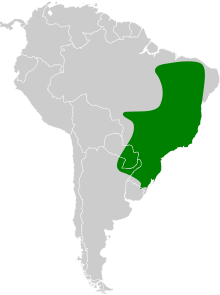| Planalto woodcreeper | |
|---|---|

| |
| Conservation status | |
 Least Concern (IUCN 3.1)] | |
| Scientific classification | |
| Domain: | Eukaryota |
| Kingdom: | Animalia |
| Phylum: | Chordata |
| Class: | Aves |
| Order: | Passeriformes |
| Family: | Furnariidae |
| Genus: | Dendrocolaptes |
| Species: | D. platyrostris |
| Binomial name | |
| Dendrocolaptes platyrostris Spix, 1824 | |

| |
The planalto woodcreeper (Dendrocolaptes platyrostris) is a sub-oscine passerine bird in subfamily Dendrocolaptinae of the ovenbird family Furnariidae. It is found in Argentina, Brazil, Paraguay, and Uruguay.
Taxonomy and systematics
The planalto woodcreeper is most closely related to the black-banded woodcreeper (D. picumnus) and Hoffmanns's woodcreeper (D. hoffmannsi) and several authors have suggested that they are conspecific. It has two subspecies, the nominate D. p. platyrostris (Spix, 1824) and D. p. intermedius (Berlepsch, 1883). At least one work has suggested that vocal differences between them warrant their treatment as separate species, but later work does not support that separation.
Description
The planalto woodcreeper is one of the larger members of its subfamily. It is slim, with a long tail and a medium-length straight bill. It is 25 to 27 cm (9.8 to 11 in) long and weighs 43 to 69 g (1.5 to 2.4 oz). The sexes have the same plumage. Adults of the nominate subspecies have a dusky face with bold buffy streaks and a faint supercilium. Their forehead, crown, and nape are black with bold buff streaks on the crown and nape. Their back and rump are olive-brown with thin buff streaks. Their wings, uppertail coverts, and tail are dull chestnut, with dusky tips on the primaries. Their throat is whitish with faint streaking and mottling. Their breast is olive-brown with strong whitish buff streaks. Their belly, flanks, and undertail coverts are buffy brown with thin blackish bars. Their iris is brown, their bill black with sometimes a paler tip to the mandible, and their legs and feet greenish gray to black. Subspecies D. p. intermedius is paler than the nominate with a more cinnamon color overall, a dusky brown or olive crown, few or no streaks on the back, and more rufous wings, rump, and tail. The two subspecies' plumages intergrade in their contact zone.
Distribution and habitat
The nominate subspecies of the planalto woodcreeper is the more southerly of the two. It is found in eastern and southeastern Brazil from Bahia and Minas Gerais south through Rio Grande do Sul into northeastern Argentina as far as eastern Corrientes Province and very slightly into northeastern Uruguay. Subspecies D. p. intermedius is found further north and west, in northeastern, central, and south central Brazil from southeastern Pará south to Mato Grosso do Sul and eastern Paraguay. Both subspecies range east to the Atlantic coast.
The planalto woodcreeper inhabits a variety of wooded landscapes. The nominate subspecies is mostly found in humid lowland and montane forests. D. p. intermedius occurs in dryer habitats such as deciduous woodland, palm swamps, and gallery forest in relatively open caatinga and cerrado. The species favors the interior of primary forest but also occurs at its edges and in mature secondary forest.
Behavior
Movement
The planalto woodcreeper is a year-round resident throughout its range.
Feeding
The planalto woodcreeper's diet is mostly arthropods but also includes small vertebrates such as frogs and a small amount of vegetable matter. It often follows army ant swarms and joins mixed-species feeding flocks. When attending ant swarms it perches low to the ground and sallies to capture prey. Away from ants it forages at all levels of the forest both by sallies from a perch and by gleaning from foliage and bark.
Breeding
The planalto woodcreeper's breeding season appears to vary somewhat geographically but generally is within October to January. It usually nests in natural cavities that it adds bark chips to, but has also been noted using nest boxes. The clutch size is three or four eggs. The incubation period is 14 to 16 days and fledging occurs 16 to 18 days after hatch.
|
Songs and calls Listen to planalto woodcreeper on xeno-canto |
Vocalization
The planalto woodcreeper mostly sings at dawn and dusk. The song of the nominate subspecies is a series of "relatively shrill 'whik', 'week' or 'chree' notes" that fade towards the end. That of D. p. intermedius is "a shorter series of 'yourit' or 'urit' notes". Both subspecies make calls that include "rattling, a grunting 'i-i-i', and other 'squirrel-like' grunts."
Status
The IUCN has assessed the planalto woodcreeper as being of Least Concern. It has a very large range, and though its population size is not known it is believed to be stable. No immediate threats have been identified. It is considered uncommon to fairly common in most of its range. It is thought "only moderately sensitive to human disturbance, which may explain continued presence at many somewhat degraded sites."
References
- ^ BirdLife International (2017). "Planalto Woodcreeper Dendrocolaptes platyrostris". IUCN Red List of Threatened Species. 2017: e.T22703092A110908935. doi:10.2305/IUCN.UK.2017-1.RLTS.T22703092A110908935.en. Retrieved 12 November 2021.
- ^ Gill, Frank; Donsker, David; Rasmussen, Pamela, eds. (January 2023). "Ovenbirds, woodcreepers". IOC World Bird List. v 13.1. Retrieved 27 April 2023.
- Remsen, J. V., Jr., J. I. Areta, E. Bonaccorso, S. Claramunt, A. Jaramillo, D. F. Lane, J. F. Pacheco, M. B. Robbins, F. G. Stiles, and K. J. Zimmer. 31 May 2023. Species Lists of Birds for South American Countries and Territories. https://www.museum.lsu.edu/~Remsen/SACCCountryLists.htm retrieved June 1, 2023
- Remsen, J. V., Jr., J. I. Areta, E. Bonaccorso, S. Claramunt, G. Del-Rio, A. Jaramillo, D. F. Lane, M. B. Robbins, F. G. Stiles, and K. J. Zimmer. Version 31 May 2023. A classification of the bird species of South America. American Ornithological Society. https://www.museum.lsu.edu/~Remsen/SACCBaseline.htm retrieved May 31, 2023
- ^ Marantz, C. A., A. Aleixo, L. R. Bevier, and M. A. Patten (2020). Planalto Woodcreeper (Dendrocolaptes platyrostris), version 1.0. In Birds of the World (J. del Hoyo, A. Elliott, J. Sargatal, D. A. Christie, and E. de Juana, Editors). Cornell Lab of Ornithology, Ithaca, NY, USA. https://doi.org/10.2173/bow.plawoo1.01 retrieved June 22, 2023
- Willis, E.O. and Oniki, Y. (2001). On a nest of the Planalto Woodcreeper, Dendrocolaptes platyrostris, with taxonomic and conservation notes. Wilson Bull. 113(2): 231–233.
- Cabanne, G.S., d’Horta, F.M., Meyer, D., da Silva, J.M.C. and Miyaki, C.Y. (2011). Evolution of Dendrocolaptes platyrostris (Aves: Furnariidae) between the South American open vegetation corridor and the Atlantic forest. Biol. J. Linn. Soc. 103(4): 801–820.
- ^ van Perlo, Ber (2009). A Field Guide to the Birds of Brazil. New York: Oxford University Press. p. 204. ISBN 978-0-19-530155-7.
| Taxon identifiers | |
|---|---|
| Dendrocolaptes platyrostris |
|
